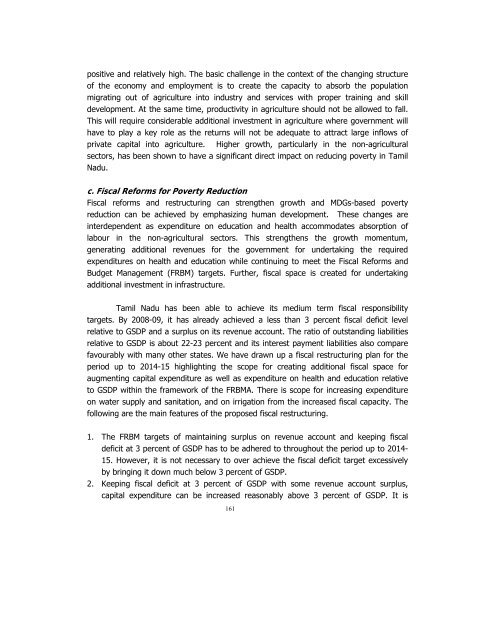POVERTY REDUCTION STRATEGY TN
You also want an ePaper? Increase the reach of your titles
YUMPU automatically turns print PDFs into web optimized ePapers that Google loves.
positive and relatively high. The basic challenge in the context of the changing structure<br />
of the economy and employment is to create the capacity to absorb the population<br />
migrating out of agriculture into industry and services with proper training and skill<br />
development. At the same time, productivity in agriculture should not be allowed to fall.<br />
This will require considerable additional investment in agriculture where government will<br />
have to play a key role as the returns will not be adequate to attract large inflows of<br />
private capital into agriculture. Higher growth, particularly in the non-agricultural<br />
sectors, has been shown to have a significant direct impact on reducing poverty in Tamil<br />
Nadu.<br />
c. Fiscal Reforms for Poverty Reduction<br />
Fiscal reforms and restructuring can strengthen growth and MDGs-based poverty<br />
reduction can be achieved by emphasizing human development. These changes are<br />
interdependent as expenditure on education and health accommodates absorption of<br />
labour in the non-agricultural sectors. This strengthens the growth momentum,<br />
generating additional revenues for the government for undertaking the required<br />
expenditures on health and education while continuing to meet the Fiscal Reforms and<br />
Budget Management (FRBM) targets. Further, fiscal space is created for undertaking<br />
additional investment in infrastructure.<br />
Tamil Nadu has been able to achieve its medium term fiscal responsibility<br />
targets. By 2008-09, it has already achieved a less than 3 percent fiscal deficit level<br />
relative to GSDP and a surplus on its revenue account. The ratio of outstanding liabilities<br />
relative to GSDP is about 22-23 percent and its interest payment liabilities also compare<br />
favourably with many other states. We have drawn up a fiscal restructuring plan for the<br />
period up to 2014-15 highlighting the scope for creating additional fiscal space for<br />
augmenting capital expenditure as well as expenditure on health and education relative<br />
to GSDP within the framework of the FRBMA. There is scope for increasing expenditure<br />
on water supply and sanitation, and on irrigation from the increased fiscal capacity. The<br />
following are the main features of the proposed fiscal restructuring.<br />
1. The FRBM targets of maintaining surplus on revenue account and keeping fiscal<br />
deficit at 3 percent of GSDP has to be adhered to throughout the period up to 2014-<br />
15. However, it is not necessary to over achieve the fiscal deficit target excessively<br />
by bringing it down much below 3 percent of GSDP.<br />
2. Keeping fiscal deficit at 3 percent of GSDP with some revenue account surplus,<br />
capital expenditure can be increased reasonably above 3 percent of GSDP. It is<br />
161

















